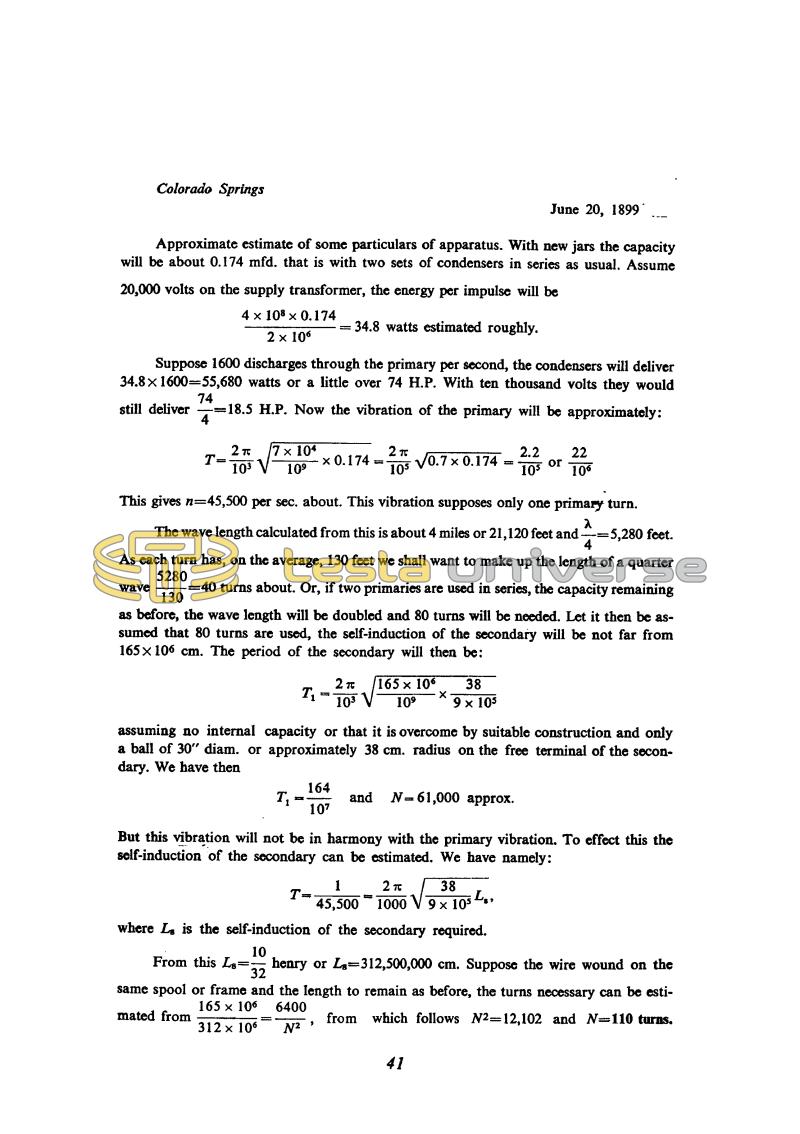
Nikola Tesla Books
Colorado Springs
June 20, 1899
Approximate estimate of some particulars of apparatus. With new jars the capacity will be about 0.174 mfd. that is with two sets of condensers in series as usual. Assume 20,000 volts on the supply transformer, the energy per impulse will be
!$ {{4 \times 10^{8} \times 0.174} \over {2 \times 10^{6} }} !$ = 34.8 watts estimated roughly.
Suppose 1600 discharges through the primary per second, the condensers will deliver 34.8 x 1600 = 55,680 watts or a little over 74 H.P. With ten thousand volts they would still deliver !$ {74 \over 4} !$ = 18.5 H.P. Now the vibration of the primary will be approximately:
T = !$ {{2 \pi \over 10^{3}} \sqrt {{7 \times 10^{4} \over 10^{9}} \times 0.174}} !$ = !$ {{2 \pi \over 10^{5}} \sqrt {0.7 \times 0.174}} !$ = !$ {2.2 \over 10^{5}} !$ or !$ {22 \over 10^{6}} !$
This gives n = 45,500 per sec. about. This vibration supposes only one primary turn.
The wave length calculated from this is about 4 miles or 21,120 feet and !$ {λ \over 4} !$ = 5,280 feet. As each turn has, on the average, 130 feet we shall want to make up the length of a quarter wave !$ {5280 \over 130} !$ = 40 turns about. Or, if two primaries are used in series, the capacity remaining as before, the wave length will be doubled and 80 turns will be needed. Let it then be assumed that 80 turns are used, the self-induction of the secondary will be not far from 165x106 cm. The period of the secondary will then be:
!$ {T_{1} = {2 \pi \over 10^{3}} {\sqrt {{{165 \times 10^{6}} \over 10^{9}} \times {38 \over {9 \times 10^{5}}}}} } !$
assuming no internal capacity or that it is overcome by suitable construction and only a ball of 30" diam. or approximately 38 cm. radius on the free terminal of the secondary. We have then
!$ {T_{1} = 164 \over 10^{7}} !$ and N = 61,000 approx.
But this vibration will not be in harmony with the primary vibration. To effect this the self-induction of the secondary can be estimated. We have namely:
!$ {T = {1 \over 45,000} = {2 \pi \over 1000} {\sqrt {38 \over {9 \times 10^{5}}} L_{s}}} !$,
where Ls is the self-induction of the secondary required.
From this Ls = !$ {10 \over 32} $1 henry or Ls = 312,500,000 cm. Suppose the wire wound on the same spool or frame and the length to remain as before, the turns necessary can be estimated from !$ {{165 \times 10^{6}} \over {312 \times 10^{6}}} = {6400 \over N^{2}} !$, from which follows N2 = 12,102 and N = 110 turns.
41
June 20
Tesla did not do the strict theoretical analysis of his oscillator operation, but he determined all essential elements on a simplified oscillator model. Following that procedure he determined the power which oscillator takes from the network by means of a primary circuit capacitor energy multiplied by capacitor discharges per second. By this method it is assumed that the energy in capacitor prior to each discharge is the same (that cannot be when the supply is provided from alternating current source) and that all capacitor energy is used up between two successive discharges.
The vibration, i.e., oscillator primary circuit resonant frequency he calculates from measured value of primary inductance and primary capacitance. The primary consists of two turns (please see June 17). When he uses one turn the previously determined primary inductance he divides by four. The capacitance is somewhat higher than the one measured on June 18 with old "jars". From so determined inductance and capacitance values he determines the primary circuit oscillation period by means of Thomson's equation for circuit without losses. Following his calculation method, Tesla calculates wavelength on the basis of oscillator primary circuit period and from there he finds secondary number of turns so that secondary wire length is one quarter of wavelength (please see comment on June 18). With two primary turns, when the primary inductance is approximately four folded, the period is doubled, he makes a judgment that 80 turns will be required. The inductance of a secondary with 80 turns he estimates on the basis of known inductance of a secondary with 12 turns (please see June 18), considering that the ratio of the inductances is equal to the ratio of corresponding number of turns squared. From this estimated inductance and assuming that the secondary does not have distributed capacitance and that the only capacitance in the secondary circuit originates from the metal sphere, Tesla determines the secondary period. Because the obtained secondary resonant frequency is high, he calculates the secondary inductance with which the same period will be obtained for primary and secondary circuit. For such obtained inductance he calculates the required secondary number of turns but he doesn't comment on this result, although the wirelength in the secondary exceeds the length of a quarter of a wave.
It is interesting that for the first time in the notes he mentioned the expenditures and that leads him to think of other methods to reduce the secondary resonant frequency (by application of a bigger sphere or disc).

